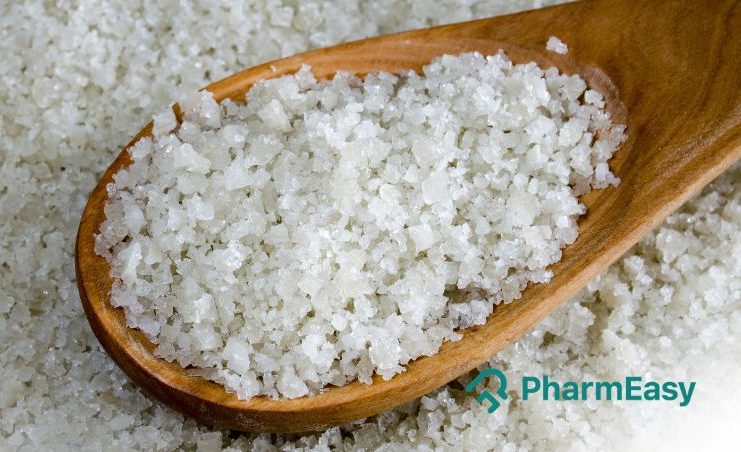Celtic Salt: Benefits, Nutritional Value, Side Effects & More!
By Dr. Ashish Bajaj +2 more

Get,

to manage your symptom
Get your,


4 Cr+ families
benefitted

OTP sent to 9988776655



You’ve successfully subscribed to receive
doctor-approved tips on
Whatsapp

Get ready to feel your best.

Hi There,
Download the PharmEasy App now!!


Register to Avail the Offer
Send OTPBy continuing, you agree with our Privacy Policy and Terms and Conditions

Hi There,
Sign up on PharmEasy now!!
Trusted by 4 crore+ families

OTP sent to 9988776655



You have unlocked 25% off on medicines




Code: NU25
By Dr. Ashish Bajaj +2 more
Table of Contents
Celtic sea salt has grown in popularity among individuals who are mindful of their dietary choices, owing to its distinctive properties and the presence of naturally occurring trace minerals. However, it is important to examine whether the purported health-related claims are supported by credible evidence1.
Celtic sea salt, also known as sel gris or grey salt, is a minimally processed variety of salt that originates from the coastal regions of France. It is recognised for its unique characteristics, which distinguish it from more commonly used salts. In this section, we will explore its historical background, geographical origins, and the features that contribute to its distinct identity1.

Celtic sea salt or “French grey salt” was originally harvested from the coastal region of Brittany in north-western France. Today, similar methods are used in various parts of the world, including regions such as Guatemala and Hawaii. The salt is traditionally produced through the natural evaporation of seawater in clay ponds, a method that results in the formation of coarse, greyish crystals1.
Celtic sea salt is often noted for its distinctive taste, appearance, and mineral composition. Unlike highly refined table salt, it undergoes minimal processing, which helps it retain trace amounts of naturally occurring minerals such as magnesium, calcium, and potassium. These minerals play various roles in supporting normal bodily functions and contribute to the salt’s characteristic flavour and texture.
Celtic sea salt is one of several options available to meet dietary sodium requirements. To understand what sets it apart, it is helpful to compare it with other widely used salts, including refined table salt, Himalayan pink salt, and Dead Sea salt. Each variety differs in origin, processing methods, mineral content, and culinary or cosmetic applications. The following section explores these distinctions in greater detail.
Conventional table salt undergoes extensive processing, which removes most naturally occurring minerals. The result is a highly refined product composed primarily of sodium chloride. To improve flow and shelf life, anti-caking agents are often added. Additionally, table salt is commonly iodised, a public health measure introduced to help prevent iodine deficiency, which can affect thyroid function.
While table salt is widely used in households and food manufacturing, excessive intake of sodium has been linked to health concerns such as high blood pressure and an increased risk of cardiovascular disease. For this reason, it is generally recommended to use salt in moderation, regardless of the type2.
Himalayan pink salt is a popular alternative to conventional table salt and is mined from ancient sea beds in the Punjab region of Pakistan. Like Celtic sea salt, it contains trace minerals, although the exact composition may vary. The two salts differ notably in appearance and texture: Celtic sea salt is typically grey in colour and retains a slightly moist consistency due to its traditional harvesting methods, whereas Himalayan pink salt is dry and ranges in hue from light pink to deep rose, attributed to its iron content2.
Unlike Celtic sea salt or Himalayan pink salt, Dead Sea salt is is not intended for consumption. It is harvested from the highly saline waters of the Dead Sea, located between Jordan and Israel. Known for its exceptionally high mineral content, particularly magnesium and bromide, Dead Sea salt is primarily used in skincare products and therapeutic treatments. Due to its mineral concentration, especially the elevated levels of certain compounds, it is not considered safe or suitable for dietary use3.
Kosher salt is a coarse variety of salt traditionally used in the preparation of kosher meats, in accordance with Jewish dietary laws. It consists purely of sodium chloride and typically contains no additives, including iodine. The larger grain size makes it easier to handle and measure during cooking, which is why it is favoured by many chefs for seasoning and food preparation2.
Refined salt is produced by extensively processing natural salt to remove impurities and naturally occurring minerals. The resulting product is composed almost entirely of sodium chloride and is often fortified with iodine to help prevent iodine deficiency. Refined salt is commonly used in processed and packaged foods due to its fine texture and long shelf life. However, excessive intake of refined salt, and sodium in general has been associated with health risks such as high blood pressure and related cardiovascular conditions2.
100 gram of Celtic Sea Salt has the following nutrient content4:
Celtic sea salt is rich in electrolytes like sodium, potassium, and magnesium. These minerals play important roles in maintaining fluid balance in the body, supporting nerve function, and aiding muscle activity. Including small amounts of mineral-rich salts like Celtic sea salt in a balanced diet may contribute to maintaining proper hydration and electrolyte levels. However, it is important to consume all types of salt in moderation, in line with recommended dietary guidelines5.
Unlike highly refined table salt, Celtic sea salt is sometimes suggested to have alkalising properties, meaning it may help support the body’s acid-alkaline balance. While some believe that maintaining a balanced pH level can contribute to overall wellbeing, scientific evidence in this area is still developing. As such, any health claims regarding alkalinity should be approached with caution and not taken as medical advice5.
The trace minerals and elements in Celtic sea salt might support immunity. From an Ayurvedic perspective, the concept of Ojas, considered the essence of vitality, digestion, and immunity is believed to be supported by wholesome and natural foods. In this traditional view, unrefined salts such as Celtic sea salt are thought to contribute to overall wellbeing. However, these insights should be seen as part of a broader holistic approach and not as a substitute for evidence-based medical advice5.
Celtic sea salt is sometimes thought to stimulate the production of saliva and gastric secretions, which play a role in the initial stages of digestion, particularly in breaking down carbohydrates. However, consult a doctor to know whether adding Celtic salt to your diet is beneficial in your case5.
Celtic sea salt, being minimally processed, is sometimes suggested to support the body’s natural detoxification processes. It is believed to assist in the elimination of certain waste products, which may contribute to a sense of overall wellbeing5.
Diluting Celtic sea salt in warm water is traditionally believed to provide soothing effects for certain skin conditions5.
Consider making kimchi with Celtic salt, instead of other salts as it may offer many health benefits because of its anti-inflammatory and antioxidant properties10.
Dr. Rajeev Singh, BAMS
While Celtic sea salt offers certain advantages, it is important to be aware of potential drawbacks as follows:
Celtic sea salt, like all types of salt, has sodium. Research indicates that excessive sodium intake may increase the risk of high blood pressure and cardiovascular issues. Individuals with hypertension or those at risk are advised to monitor their overall sodium consumption, including the amount of Celtic sea salt used in their diet. Maintaining sodium intake within recommended limits is important for supporting heart health6.
Unlike many commercially available table salts, which are commonly fortified with iodine, Celtic sea salt does not typically contain added iodine. Iodine is an essential nutrient important for proper thyroid function and metabolic health. Therefore, individuals who rely solely on Celtic sea salt for their sodium intake should ensure they obtain adequate iodine from other dietary sources or supplements to maintain balanced nutrition8.
There are concerns about the presence of heavy metals, such as lead, in some sea salts, including Celtic sea salt. The levels of these contaminants can vary depending on the geographic origin and environmental conditions of the salt’s source. Although lead concentrations are generally low, there may still be potential risks, particularly for vulnerable groups such as pregnant women and young children.
To minimise exposure, it is advisable to purchase Celtic sea salt from reputable suppliers who regularly test their products for heavy metals and other contaminants. Some sourcing regions may carry a higher risk of contamination than others. If you have concerns about heavy metals in salt, it is recommended to discuss these with a healthcare professional and choose products from trusted sources8.
Although Celtic sea salt is sometimes suggested to support blood sugar balance, individuals with diabetes should carefully monitor their overall salt intake. It is important to consult a healthcare professional before considering Celtic salt for any health-related purpose, including blood sugar management. Proper medical advice ensures safe and effective care7.
People with metal sensitivities should also be cautious when using Celtic salt, as it may contain trace amounts of metals like iron and zinc8.
A necessary component of the fermenting process for kimchi is Celtic salt. Its mineral content and natural properties contribute to the development of flavour and help support the fermentation environment. Celtic salt demonstrated notable antioxidant activity and was observed to reduce certain markers of inflammation with minimal cytotoxicity in laboratory settings. The study also suggested potential anti-obesity and anti-cancer properties based on early-stage findings. However, do not use this as treatment for any of these conditions without consulting a doctor10.
Dr. Siddharth Gupta, B.A.M.S, M.D (Ayu)
If you are considering incorporating Celtic sea salt into your diet, it is important to understand the appropriate quantity and methods of use. The following recommendations provide guidance on daily intake and practical tips for making the most of this distinctive salt.
A general rule for healthy adults is a maximum of 3 g of salt per day9. However, individual requirements can vary based on factors such as age, health status, and lifestyle. Therefore, it is advisable to consult a healthcare professional before making any significant changes to your salt consumption.
Celtic sea salt offers a distinctive alternative to conventional table salt in cooking, baking, and seasoning. Its unique flavour and texture make it especially popular as a finishing salt, enhancing the taste and presentation of dishes. Using Celtic sea salt can elevate your culinary creations by adding a subtle richness and depth of flavour.
It is sometimes suggested that adding a small amount of Celtic sea salt to water may help support hydration, particularly for individuals such as athletes or those with naturally low sodium levels. However, for most people, this is unnecessary. Maintaining hydration is best achieved through a balanced diet rich in electrolyte-containing foods and adequate fluid intake. Saltwater alone should not be relied upon as the primary means of staying hydrated.
Also Read: 14 Health Benefits of Amaranth Leaves That You Must Know
Both Ayurvedic healing and Western medicine recognise some potential benefits of Celtic sea salt, including support for immunity and digestion. However, they also caution that excessive sodium intake may pose risks to heart health. As with any dietary change or supplement, it is advisable to consult a healthcare professional before making significant adjustments.
In Ayurvedic raw sea salts, including Celtic sea salt are traditionally believed to support throat health, help clear nasal passages, and assist the body’s natural detoxification processes. The Ayurvedic concept of Ojas, regarded as the essence of strong digestion and immunity, reflects the belief that natural, unrefined salts contribute to overall wellness. While these traditional views align in part with modern understanding of mineral roles in bodily function, they should be seen as complementary to, not a replacement for, evidence-based medical guidance7.
While acknowledging certain benefits attributed to Celtic sea salt, Western medicine emphasises the importance of monitoring and limiting overall sodium intake. Excessive salt consumption is linked to increased risk of high blood pressure and cardiovascular disease. Therefore, maintaining an appropriate balance is essential for supporting good health1.
Also Read: Foods That Naturally Help You Last Longer in Bed
Celtic sea salt offers a refreshing alternative to traditional table salt, with potential health benefits and a unique culinary experience that appeals to those seeking a natural and nutritious addition to their diet. However, it is important to remember that excessive sodium intake, regardless of the source, carries health risks. Any significant dietary changes should be made with the guidance of a healthcare professional.
Also Read: Top Benefits of Taking Multivitamin Capsules
Celtic sea salt has a unique flavour, characterised by an earthy note. Its crystals tend to be larger and slightly moist compared to salts such as table salt and Himalayan pink salt, offering a distinctive texture and taste experience.
Celtic sea salt is considered a healthier alternative to refined table salt due to its unrefined nature and mineral content. However, it is important to consume it in moderation and as part of a balanced diet. Other natural salts such as Himalayan salt and Fleur de Sel also have their own health benefits and can be used as alternatives to refined salt.
Yes, Celtic sea salt can be used as a part of daily cooking, baking, or flavouring food. Its unique taste and texture make it an alternative to table salt.
Like all salts, Celtic sea salt contains sodium. If you are following a low-sodium diet, it is important to monitor your overall sodium intake carefully. Before incorporating Celtic sea salt into your diet, please consult a healthcare professional for personalised advice.
Consuming excessive sodium, regardless of the source, can contribute to health problems such as high blood pressure and cardiovascular disease. It is important to maintain a balanced diet and consult a healthcare professional before introducing Celtic sea salt or making significant changes to your salt intake.
To ensure you are purchasing genuine Celtic sea salt, select trusted brands and reputable sources. Reliable suppliers typically provide details about the salt’s origin, production methods, and mineral composition.
Celtic sea salt has several benefits for the skin. It contains minerals such as magnesium, calcium, and potassium, which help to nourish and hydrate the skin.
Celtic salt can also help to exfoliate dead skin cells and unclog pores, leading to clearer and brighter skin. Additionally, it can help to balance the skin’s pH levels, reducing inflammation and irritation.
Yes, Celtic sea salt naturally contains trace amounts of iodine, but the concentration can vary. It is not a reliable source of iodine compared to iodised table salt, which is fortified specifically to prevent iodine deficiency.
Maldon salt is not considered as Celtic sea salt. It is harvested from seawater in Essex, England, using traditional methods, whereas Celtic sea salt generally refers to salt collected from the coastal regions of Brittany, France. Both salts are valued for their distinctive textures and flavours but differ in their geographical origin and characteristics.
Celtic sea salt is a type of sea salt that is harvested from the coastal regions of Brittany, France, using traditional methods. It is minimally processed and retains trace minerals. While all Celtic sea salt is sea salt, not all sea salts are Celtic sea salt, as sea salt can come from various coastal regions worldwide with different harvesting methods and mineral compositions.
Disclaimer: The information provided here is for educational/awareness purposes only and is not intended to be a substitute for medical treatment by a healthcare professional and should not be relied upon to diagnose or treat any medical condition. The reader should consult a registered medical practitioner to determine the appropriateness of the information and before consuming any medication. PharmEasy does not provide any guarantee or warranty (express or implied) regarding the accuracy, adequacy, completeness, legality, reliability or usefulness of the information; and disclaims any liability arising thereof.
Comments

Leave your comment...
You may also like
Comments